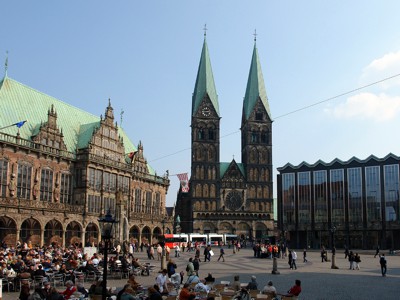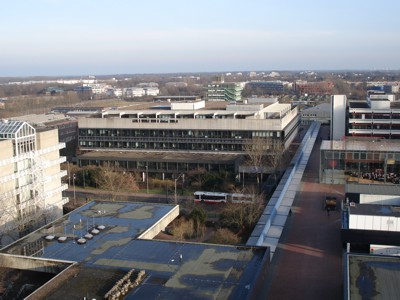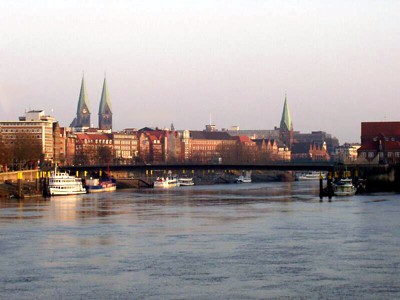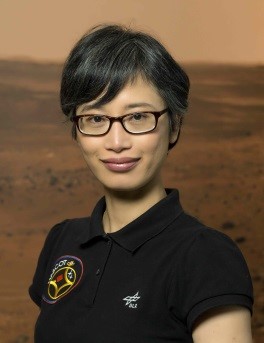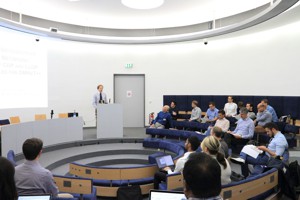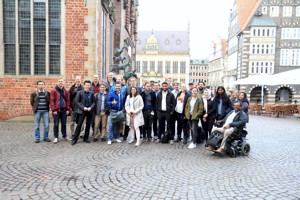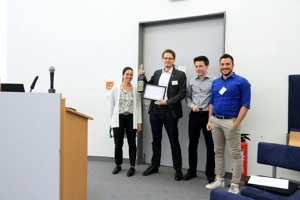OMNeT++ Community Summit 2017
Successor of the International Workshop on OMNeT++
University of Bremen – Germany – September 07 - 08
INTRODUCTION
The fourth OMNeT++ Community Summit will be held at the University of Bremen in Germany on Thursday and Friday, September 07 - 08, 2017.
OMNeT++ is a public-source, component-based, modular and open-architecture simulation environment with strong GUI support and an embeddable simulation kernel. It is designed to simulate discrete event systems, with the simulation of communication networks as one of its primary application areas.
In continuation of the history of the International Workshop on OMNeT++ and three very successful editions of its reincarnation, the OMNeT++ Community Summit, we continue on the path of holding a yearly, open meeting for all members of the OMNeT++ community with less costs and more interaction between the participants. The Community Summit provides a forum for tutorials, discussion sessions and presentations on recent developments and novel ideas in the area of simulation and modeling, with a focus on the OMNeT++ simulation environment.
The first three Summits in Hamburg, Zurich, and Brno were huge successes with lively discussions, keynotes, tutorials and panels, as well as presentations and demonstrations of ongoing and finalized research covering many aspects of OMNeT++-related research. The 2017 event continues to expand the idea of a yearly community summit by explicitly addressing the interaction through tutorials and panels with additional discussion slots while keeping the extended 2-day time frame of the last summits.

SUMMIT PROGRAM
The OMNeT++ Summit intends to be a lively event with a lot of discussions. A wide range of presentations, tutorials, and demonstrations regarding specific topics will be held. There will be enough time to discuss about the different parts of OMNeT++ and related simulation and modeling questions.
Proceedings
Thursday, 07. September 2017 |
All sessions will take place at the University of Bremen - Cartesium (CART) building - Room 067 - Ground Floor. Please follow the OMNeT++ Community Summit signs. |
|
| 10:00 - 10:15 | Registration | |
| 10:15 - 10:30 | Summit Welcome Note
⇒ Presentation Slides [PDF] – Presentation [Video] |
|
| 10:30 - 12:00 | Session: Vehicular Network Simulation Session Chair: Michael Kirsche |
|
|
Benjamin Sliwa, Johannes Pillmann, Fabian Eckermann and Christian Wietfeld LIMoSim: A Lightweight and Integrated Approach for Simulating Vehicular Mobility with OMNeT++ Reliable and efficient communication is one of the key requirements for the deployment of self-driving cars. Consequently, researchers and developers require efficient and precise tools for the parallel development of vehicular mobility and communication. Although current state-of-the-art approaches allow the coupled simulation of those two components, they are making use of multiple specialized simulators that are synchronized using interprocess communication, resulting in highly complex simulation setups. Furthermore, the compatibility of those simulators requires constant attention as they are developed independently. In this paper, we present a lightweight and integrated approach for simulating vehicular mobility directly in Objective Modular Network Testbed in C++ (OMNeT++) and INET without the need for external tools or Interprocess Communication (IPC). The proposed framework Lightweight ICT-centric Mobility Simulation (LIMoSim) is available as Open Source software and can easily be combined with other third-party extension frameworks for providing vehicular mobility based on well-known microscopical models. In contrast to existing approaches, the amount of necessary preprocessing steps for simulation setups is significantly reduced. The capabilities of LIMoSim are demonstrated by a proof of concept evaluation in combination with the Long Term Evolution (LTE) simulation framework SimuLTE. ⇒ arXiv Page – Publication [PDF] – Presentation Slides [PDF] – Presentation [Video] |
||
|
Christina Obermaier and Christian Facchi Observations on OMNeT++ Real-Time Behaviour OMNeT++ is a widely used platform for all types of network simulations. The open source simulation framework Artery can be used to perform Vehicular Ad Hoc Network (VANET) simulations. This paper presents an approach for connecting this simulation and real-world VANET hardware to extend the test range and investigates the real-time behaviour of the simulation. As a Device Under Test (DUT) depends on real-time data to perform properly, different simulation scenarios running different hardware setups are presented. Additionally, the paper deals with the impacts of real-time losses on the test run outcomes. Most time dependant algorithms like the duplicate packet detection do not need very accurate real-time data and thus could be verified using the presented approach. Otherwise, in some cases such as testing of multi-hop communication, accurate real time is crucial. ⇒ arXiv Page – Publication [PDF] – Presentation Slides [PDF] – Presentation [Video] |
||
|
Giovanni Nardini, Antonio Virdis and Giovanni Stea Simulating Cellular Communications in Vehicular Networks: Making SimuLTE Interoperable with Veins The evolution of cellular technologies toward 5G progressively enables efficient and ubiquitous communications in an increasing number of fields. Among these, vehicular networks are being considered as one of the most promising and challenging applications, requiring support for communications in high-speed mobility and delay-constrained information exchange in proximity. In this context, simulation frameworks under the OMNeT++ umbrella are already available: SimuLTE and Veins for cellular and vehicular systems, respectively. In this paper, we describe the modifications that make SimuLTE interoperable with Veins and INET, which leverage the OMNeT++ paradigm, and allow us to achieve our goal without any modification to either of the latter two. We discuss the limitations of the previous solution, namely VeinsLTE, which integrates all three in a single framework, thus preventing independent evolution and upgrades of each building block. ⇒ arXiv Page – Publication [PDF] – Presentation Slides [PDF] – Presentation [Video] |
||
| 12:00 - 13:15 | Lunch Break (self-paid) | |
| 13:15 - 14:30 | Session: New Models and Simulators Session Chair: Kyeong Soo (Joseph) Kim |
|
|
Behruz Khalilov, Anna Foerster and Asanga Udugama Radio Irregularity Model in OMNeT++ Radio irregularity is a non-negligible phenomenon that has an impact on protocol performances. For instance, irregularity in radio range leads to asymmetric links that cause the loss of packets in different directions. In order to investigate its effect, the Radio Irregularity Model (RIM) is proposed that takes into account the irregularity of a radio range and estimates path losses in an anisotropic environment. The purpose of this paper is to provide details of the RIM model developed in the INET Framework of the OMNeT++ simulator that can be used to investigate the impact of radio irregularity on protocol performance. ⇒ arXiv Page – Publication [PDF] – Presentation Slides [PDF] – Presentation [Video] |
||
|
Vladimir Vesely and Tomáš Rajca Discovering Neighbor Devices in Computer Network: Development of CDP and LLDP Simulation Modules for OMNeT++ The purpose of data-link layer discovery protocols is to provide the network administrator with the current information (i.e., various Layer 2 and 3 parameters) about neighbor devices. These protocols are invaluable for network monitoring, maintenance, and troubleshooting. However, they start to play an important role in the operation of data-centers and other high-availability networks. This paper outlines design, implementation and deployment of Cisco Discovery Protocol and Link Layer Discovery Protocol simulation modules in OMNeT++ simulator. ⇒ arXiv Page – Publication [PDF] – Presentation Slides [PDF] – Presentation [Video] |
||
|
Asanga Udugama, Anna Foerster, Jens Dede, Vishnupriya Kuppusamy and Anas Bin Muslim Opportunistic Networking Protocol Simulator for OMNeT++ The number of computing devices of the Internet of Things (IoT) is expected to grow by billions. New networking architectures are being considered to handle communications in the IoT. One of these architectures is Opportunistic Networking (OppNets). To evaluate the performance of OppNets, an OMNeT++ based modular simulator is built with models that handle the operations of the different protocol layers of an OppNets based node. The work presented here provides the details of this simulator, called the Opportunistic Protocol Simulator (OPS). ⇒ arXiv Page – Publication [PDF] – Presentation Slides [PDF] – Presentation [Video] |
||
| 14:30 - 15:00 | Tutorial: Reproducibility | |
|
Kyeong Soo (Joseph) Kim Reproducible Research for OMNeT++ Based on Python and Pweave As the amount and complexity of model implementation code, configuration files, and resulting data for simulation experiments are ever increasing, it becomes a real challenge to reliably and efficiently reproduce simulation data and their analysis results published in a scientific paper not only by its readers but also the authors themselves, which makes the claims and contributions made in the paper questionable. The idea of reproducible research comes as a solution to these problems and suggests that any scientific claims should be published together with relevant experimental data and software code for their analysis so that readers may verify the findings and build upon them; in case of computer simulation, the details of simulation implementation and its configurations are also should be provided. In this tutorial, we illustrate the practice of the reproducible research for OMNeT++ simulation based on Pweave and Python, where we show how to embed simulation configuration files and Python analysis code, to import simulation data with automatic updating of simulation results, and to analyze data and present their results in a LaTeX file. ⇒ Supporting Materials (@ Github) – Presentation Slides [PDF] – Presentation [Video] |
||
| 15:00 - 15:30 | Coffee Break | |
| 15:30 - 16:00 | Tutorial: Simulation Campaigns | |
|
Attila Török Running Simulation Campaigns in the Cloud Simulation studies can easily consist of hundreds or thousands of runs, and take many hours to complete. At the same time, cloud computing services have gained popularity, and significant computing power has become easily available for researchers at a low cost. This presentation will introduce you to the possibility of running OMNeT++ simulation campaigns in the cloud. ⇒ Presentation Slides [PDF] – Presentation [Video] |
||
| 16:00 - 17:15 | Session: Mobility Modeling Session Chair: Antonio Virdis |
|
|
Anna Förster, Anas Bin Muslim and Asanga Udugama Reactive User Behavior and Mobility Models In this paper, we present a set of simulation models to more realistically mimic the behaviour of users reading messages. We propose a User Behaviour Model, where a simulated user reacts to a message by a flexible set of possible reactions (e.g. ignore, read, like, save, etc.) and a mobility-based reaction (visit a place, run away from danger, etc.). We describe our models and their implementation in OMNeT++. We strongly believe that these models will significantly contribute to the state of the art of simulating realistically opportunistic networks. ⇒ arXiv Page – Publication [PDF] – Presentation Slides [PDF] – Presentation [Video] |
||
|
Zeynep Vatandas, Manikandan Venkateswaran, Koojana Kuladinithi and Andreas Timm-Giel Parameterization of SWIM Mobility Model Using Contact Traces Opportunistic networks (OppNets) are focused to exploit direct, localised communications which occur in a peer-to-peer manner mostly based on people’s movements and their contact durations. Therefore, the use of realistic mobility models is critical to evaluate the data dissemination in OppNets. One of the mobility models that is available in OMNeT++ which can be used to mimic human movement patterns is Small Worlds in Motion (SWIM). The SWIM model is based on the intuition that humans often visit nearby locations and if the visited location is far away, then it is probably due to the popularity of the location. As an alternative to mobility of a node, pairwise contact probabilities are also used to evaluate the data dissemination in OppNets. Pairwise contact probabilities can be used to predict that a node will be met by a particular node. These probabilities can be derived in many ways. One of the ways is to calculate the average probability with which a node will meet another particular node at any point of time. Another way is to calculate the probability with which a node will meet another based on the time of day. The way of calculating pairwise contact probability depends on the scenario. In this work, the pairwise contact probabilities obtained from the real traces are used to tune the parameters of the SWIM mobility model. The traces and the SWIM model are compared in terms of contact durations, inter-contact times and, number of pairwise contacts. How to decide SWIM parameters using real contact traces are being addressed. ⇒ arXiv Page – Publication [PDF] – Presentation Slides [PDF] – Presentation [Video] |
||
|
Liu Sang, Vishnupriya Kuppusamy, Anna Förster, Asanga Udugama and Ju Liu Evaluating the Utility of UDG Using OMNeT++ Use of mobility models to model user movement in mobile networks are a key aspect when developing and evaluating networking protocols in simulators. Though trace-based mobility models are considered more realistic than synthetic models, these traces lack information about the actual wireless contact durations between users. Most simulators use Unit Disk Graph (UDG) model to determine contact durations. However, due to the nature of radio propagations, it may lead to simulating unrealistic connectivity patterns. In this work, we have used an Android smartphone application to collect GPS traces of moving users and their corresponding Bluetooth Low Energy (BLE) contact times to compare the viability of using UDG to determine contact durations in OMNeT++. The results show that trace based model with UDG based wireless connectivity is an effective method to determine contact durations. ⇒ Presentation Slides [PDF] – Presentation [Video] |
||
| 17:15 - 18:00 | Collective trip to the social event. Detailed directions will be provided on-site. | |
| 18:00 - 19:00 | Social Event (self-paid) | |
| Venue: Bremer Ratskeller Address: Am Markt, 28195 Bremen Located at the central market place, this cellar of the townhall of Bremen has a long tradition and rich history. We are going to visit the wine cellar and take an official tour. |
||
| 19:15 - open end |
Discussion and Dinner (self-paid) | |
| Dinner Venue: StadtWIRT Restaurant Address: Katharinenklosterhof 7, 28195 Bremen |
||
Friday, 08. September 2017 |
All sessions will take place at the University of Bremen - Cartesium (CART) building - Room 067 - Ground Floor. Please follow the OMNeT++ Community Summit signs. |
|
| 09:00 - 09:45 | Keynote Session Chair: Anna Förster |
|
|
Dr. Tra-Mi Ho (German Aerospace Center - Institute of Space Systems) The MASCOT Lander Onboard the Hayabusa2 Mission – Its Communication and Operations Strategy – MASCOT is a small asteroid lander launched on December 3rd, 2014, aboard the Japanese Hayabusa2 asteroid sample-return mission towards the 980m diameter C-type near-Earth asteroid (NEA) 162173 Ryugu. They keynote will present the system design, the science instruments, and the communication and operational concept of MASCOT. |
||
| 09:45 - 10:15 | Coffee Break | |
| 10:15 - 11:45 | Session: OMNeT++ Developments Session Chair: Michael Kirsche |
|
|
Maximilian Köstler and Florian Kauer A Remote Interface for Live Interaction with OMNeT++ Simulations Discrete event simulators, such as OMNeT++, provide fast and convenient methods for the assessment of algorithms and protocols, especially in the context of wired and wireless networks. Usually, simulation parameters such as topology and traffic patterns are predefined to observe the behaviour reproducibly. However, for learning about the dynamic behaviour of a system, a live interaction that allows changing parameters on the fly is very helpful. This is especially interesting for providing interactive demonstrations at conferences and fairs. In this paper, we present a remote interface to OMNeT++ simulations that can be used to control the simulations while visualising real-time data merged from multiple OMNeT++ instances. We explain the software architecture behind our framework and how it can be used to build demonstrations on the foundation of OMNeT++. ⇒ arXiv Page – Publication [PDF] – Presentation Slides [PDF] – Presentation [Video] |
||
|
Henning Puttnies, Peter Danielis, Christian Koch and Dirk Timmermann Java Extensions for OMNeT++ On the one side, network simulation frameworks are important tools for research and development activities to evaluate novel approaches in a time- and cost-efficient way. On the other side, Java as a highly platform-independent programming language is ideally suited for rapid prototyping in heterogeneous scenarios. Consequently, Java simulation frameworks could be used to firstly perform functional verification of new approaches (and protocols) in a simulation environment and afterwards, to evaluate these approaches in real testbeds using prototype Java implementations. Finally, the simulation models can be refined using real world measurement data. Unfortunately, there is to the best of our knowledge no satisfying Java framework for network simulation, as the OMNeT++ Java support ended with OMNeT++ version 4.6. Hence, our contributions are as follows: we present Java extensions for OMNeT++ 5.0 that enable the execution of Java simulation models and give a detailed explanation of the working principles of the OMNeT++ Java extensions that are based on Java Native Interface. We conduct several case studies to evaluate the concept of Java extensions for OMNeT++. Most importantly, we show that the combined use of Java simulation models and C++ models (e.g., from the INET framework) is possible. ⇒ arXiv Page – Publication [PDF] – Presentation Slides [PDF] – Presentation [Video] |
||
|
Invited Speaker: András Varga OMNeT++ Best Practices Reloaded: Result Analysis For several years, efforts have been going on in the OMNeT++ development team to improve the tool's support and associated best practices for simulation campaigns and subsequent result analysis. This presentation addresses the latest developments and recommended best practices in the area of result analysis, with special attention to the emerging dominance of a programming language named after an animal as a data analysis platform. ⇒ Presentation Slides [PDF] – Presentation [Video] |
||
| 11:45 - 13:15 | Lunch Break (on-site) with Poster and Demo Session | |
| 13:15 - 14:15 | Session: INET Developments Session Chair: Antonio Virdis, Michael Kirsche |
|
|
Invited Speaker: Levente Meszaros INET 4 - Features and Porting The upcoming INET 4.0 version contains a few non-trivial backward incompatible changes. These changes have profound effects on the internal structure of network nodes, on how applications can use protocols, on how protocols communicate with each other, and on how packets are represented internally and presented to the user in the runtime environment. The migration of existing projects to the new version may require considerable efforts from INET users. Understanding the motivation behind these changes is important for the spreading and acceptance of the new version. We believe that these changes will greatly increase the productivity of users and potentially open up new ways of using INET by researchers. In this talk, we explain the motivations, present the resulting technical solutions and provide some practical advice to aid porting. ⇒ Presentation Slides [PDF] – Presentation [Video] |
||
|
Interactive Question & Answer Session with the OMNeT++ Core Development Team Q&A Session We are proud to announce an interactive "Question & Answer" session with the OMNeT++ core development team. ⇒ Presentation Slides [PDF] – Presentation [Video] |
||
| 14:15 - 14:30 | Summit Closure Note + "Best Contribution Award"
Best Contribution 2017: Benjamin Sliwa et. al. LIMoSim - A Lightweight and Integrated Approach for Simulating Vehicular Mobility with OMNeT++ ⇒ Presentation Slides [PDF] – Presentation [Video] |
|
Keynote Speaker
The MASCOT Lander Onboard the Hayabusa2 Mission
– Its Communication and Operations Strategy –
MASCOT is a small asteroid lander launched on December 3rd, 2014, aboard the Japanese Hayabusa2 asteroid sample-return mission towards the 980m diameter C-type near-Earth asteroid (NEA) 162173 Ryugu. The lander was jointly developed by the German Aerospace Centre (DLR) and the Centre National d'Etudes Spatiales (CNES). It is equipped with a sensor suite consisting of four fully-fledged instruments: a spectrometer (MicrOmega, IAS Paris), a camera (CAM, DLR Berlin), a radiometer (MARA, DLR Berlin) and a magnetometer (MAG, TU Braunschweig) to investigate Ryugu's surface structure, mineralogical composition, physical properties, thermal behavior and magnetic effects.
The MASCOT lander has a total weight of only ~10kg and a size of 30cm x 30cm x 20cm, comparable to a shoe-box. Next to the 4 science payloads, it accommodates all subsystems to guarantee the survival during the four years cold cruise phase and an on-surface operation and data uplink of up to 2 asteroid days.
Upon arrival in Summer 2018 at the target, Hayabusa2 will map NEA Ryugu for several months before it will release MASCOT at an altitude of approx. 100m to free fall on the asteroid's surface. Since MASCOT has no attitude control, it will reach the surface and undergo a certain bouncing phase before it will finally come to rest. A mobility system allows the lander to upright into the correct measurement attitude and to relocate across the asteroids surface after the completion of its first science cycle.
The system design, science instruments, communication and operational concept of MASCOT will be presented.
Dr. Tra-Mi Ho
System Engineering and Project Office
German Aerospace Center (DLR), Bremen
- 2000: Diploma of Physics, University of Heidelberg.
- 2004: Ph.D. of Physics, University of Bern, Bern, Switzerland.
- 2005 – 2008: Research Fellowship at ESTEC/ESA
- Since 2008: Scientific Staff at DLR Bremen (Position: MASCOT Project Manager)
- Research interest: Development of satellite and landing system. Solar System science and exploration.
IMPRESSIONS
With over 30 on-site participants, two days of high-class presentations, tutorials, demonstrations, and panel discussions, the fourth OMNeT++ Community Summit served as yet another excellent community get-together. We would like to express our gratitude to all people involved in the organization of the event and to all presenters and attendees.
Below you find impressions from the fourth summit.
SUMMIT VENUE
The 4th OMNeT++ Community Summit will take place at the University of Bremen in Germany.
On-Site Location:
University of Bremen - Building "Cartesium (CART)"
Enrique-Schmidt-Straße 5, 28359 Bremen
Accommodation Information
Hotels near the event site:
All rooms are equipped with WLAN and satellite TV. There are business and economy rooms available. For business rooms, breakfast and some other services are included in the price. For economy rooms, breakfast can be booked separately. Please contact the hotel directly for pricing information and booking using the code "OMNeT".
Address:
Wiener Straße 4
28359 Bremen
Contact:
Telephone: +49 421 24670
E-Mail: [email protected]
All rooms are equipped with WLAN and satellite TV. Breakfast can be booked separately. Please contact the hotel directly for pricing information and booking using the code "Omnet".
Address:
Universitätsallee 4
28359 Bremen
Contact:
Telephone: +49 421 69677377
E-Mail: [email protected]
For other hotels, please check for instance www.booking.com and search for Bremen.
Bremen City Information
Travel Information
If you plan to arrive by plane:
- Bremen Airport (BRE):
The airport is connected to the university campus directly by tram. The tram stop is in front of the arrival hall. Take tram nr. 6, direction "Universität". A single ticket called "Bremen zone 100" or "Preisstufe Bremen I (HB)" is 2.75 Euro, it is available in the vehicle from a big blue vending machine close to the driver's cabin. (There are smaller machines elsewhere in the vehicle, but they do not accept cash money.) Get down at the stop "Universität Süd". Walk down the road "Universitätsallee" in the direction which the tram came from, then turn left into "Enrique-Schmidt-Straße". You will see the "Cartesium" building after 150 meters on the right side. - Hamburg Airport (HAJ):
Take the "S-Bahn" nr. S1 from the airport to Hamburg main railway station. From there, various train connections are available to Bremen main station. Leave the station through the "Zentrum" exit, the tram platforms are in front of the railway station building. Take tram nr. 6, direction "Universität". A single ticket called "Bremen zone 100" or "Preisstufe Bremen I (HB)" is 2.75 Euro, it is available in the vehicle from a big blue vending machine close to the driver's cabin. (There are smaller machines elsewhere in the vehicle, but they do not accept cash money.) Get down at the stop "Universität Süd". Walk down the road "Universitätsallee" in the direction which the tram came from, then turn left into "Enrique-Schmidt-Straße." You will see the "Cartesium" building after 150 meters on the right side. - Hanover Airport (HAM):
Take the "S-Bahn" nr. 5 from the airport to Hanover main railway station. From there, various train connections are available to Bremen main station. Leave the station through the "Zentrum" exit, the tram platforms are in front of the railway station building. Take tram nr. 6, direction "Universität". A single ticket called "Bremen zone 100" or "Preisstufe Bremen I (HB)" is 2.75 Euro, it is available in the vehicle from a big blue vending machine close to the driver's cabin. (There are smaller machines elsewhere in the vehicle, but they do not accept cash money.) Get down at the stop "Universität Süd". Walk down the road "Universitätsallee" in the direction which the tram came from, then turn left into "Enrique-Schmidt-Straße". You will see the "Cartesium" building after 150 meters on the right side. - Click here for timetable and ticket information of the German railroad service "Deutsche Bahn".
- Click here for timetable and ticket information of the Bremen local public transport service "BSAG".
If you plan to arrive by train:
- Bremen main railway station is reachable via high-speed and regional trains. Leave the station through the "Zentrum" exit, the tram platforms are in front of the railway station building. Take tram nr. 6, direction "Universität". A single ticket called "Bremen zone 100" or "Preisstufe Bremen I (HB)" is 2.75 Euro, it is available in the vehicle from a big blue vending machine close to the driver's cabin. (There are smaller machines elsewhere in the vehicle, but they do not accept cash money.) Get down at the stop "Universität Süd". Walk down the road "Universitätsallee" in the direction which the tram came from, then turn left into "Enrique-Schmidt-Straße". You will see the "Cartesium" building after 150 meters on the right side.
- Click here for timetable and ticket information of the German railroad service "Deutsche Bahn".
- Click here for timetable and ticket information of the Bremen local public transport service "BSAG".
If you plan to arrive by bus:
- There are coach services from various European destinations. In Bremen, the long-distance coaches stop at the road "Breitenweg". Walk down the road in the direction which the coach came from, then turn left into "Bahnhofstraße" where the tram platforms are on the right side. Take tram nr. 6, direction "Universität". A single ticket called "Bremen zone 100" or "Preisstufe Bremen I (HB)" is 2.75 Euro, it is available in the vehicle from a big blue vending machine close to the driver's cabin. (There are smaller machines elsewhere in the vehicle, but they do not accept cash money.) Get down at the stop "Universität Süd". Walk down the road "Universitätsallee" in the direction which the tram came from, then turn left into "Enrique-Schmidt-Straße". You will see the "Cartesium" building after 150 meters on the right side.
- Click here for timetable and ticket information of the Bremen local public transport service "BSAG".
ORGANIZERS
Founding Chair
- Andras Varga (OpenSim Kft.)
Community Summit Organizers
- Anna Förster (University of Bremen, Germany)
- Asanga Udugama (University of Bremen, Germany)
- Andreas Könsgen (University of Bremen, Germany)
Technical Program Organizers
- Antonio Virdis (University of Pisa, Italy)
- Michael Kirsche (BTU Cottbus–Senftenberg, Germany)
Publicity Organizer
- Kyeong Soo (Joseph) Kim (Xi'an Jiaotong–Liverpool University, China)
- Vladimír Veselý (Brno University of Technology, Czech Republic)
Technical Program Committee
- Claudia Campolo (University of Reggio Calabria, Italy)
- Laura Marie Feeney (Uppsala University, Sweden)
- Michael Frey (HU Berlin, Germany)
- Florian Kauer (TU Hamburg-Harburg, Germany)
- Marcel Marek (University of Oslo, Norway)
- Yutaka Matsubara (Nagoya University, Japan)
- Cyriel Minkenberg (Rockley Photonics Inc., USA)
- Thi Mai Trang Nguyen (UUPMC - LIP6, France)
- Christoph Sommer (University of Paderborn, Germany)
- Mirko Stoffers (RWTH Aachen University, Germany)
- Marco Tiloca (RISE SICS, Sweden)
In case you want to contact the organizers, feel free to write an e-mail to: [email protected].
Sponsors
The OMNeT++ Community Summit 2017 is sponsored. No registration fees will apply.
We would like to thank the Communication Networks Working Group located at the Faculty of Physics and Electrical Engineering of the University of Bremen for their support in hosting the summit.



